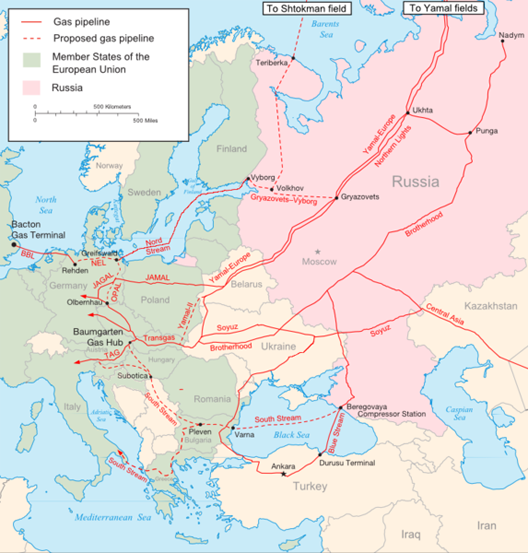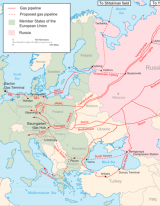Russia-Ukraine Crisis Is Now Unlikely to Let Russian Gas Keep Flowing Smoothly to Europe
European countries from Germany and Poland to Italy and Turkey now need to ensure they have emergency plans in place to deal with a possible cut-off of Russian gas supplies. At risk are the roughly one-fifth of their supplies delivered via pipelines through Ukraine, and even greater volumes if other Russian pipelines are affected. Any one of several events could reduce or halt this flow, which amounts to around 86 billion cubic meters a year.

|
The states that receive roughly 20 percent of their gas from Russia via Ukraine include a large number of European Union members, as well as Turkey, a cluster of Balkan countries, and Ukraine itself. The supplies that reach European customers by other routes are those through the Nord Stream pipeline (beneath the Baltic Sea) to Germany, the Yamal pipeline to Poland and the Blue Stream pipeline to Turkey.
A cut-off in gas pumped through Ukraine could be either deliberate or accidental — triggered by events such as military intervention, including a Russian assault on eastern or southern Ukraine, or an intensification of current disputes between Kyiv and Moscow over Russia’s gas pricing and Ukraine’s gas debts.
Countries particularly at risk include Italy, which last year relied on Russian gas that transited Ukraine to meet more than a third of its total consumption of 68.7 billion cubic meters. Italy would be particularly hard hit because one of its other principal suppliers, Algeria, has reduced output and exports following the January 2013 attack on the In Amenas gas plant by Al Qaeda-backed terrorists.
A cluster of countries that would really suffer are those in Southern and Eastern Europe that have joined the European Union in the past ten years. Collectively, seven of these new EU members – Bulgaria, Croatia, the Czech Republic, Hungary, Romania, Slovakia and Slovenia – together with some non-EU states like Serbia and Macedonia, rely on Ukrainian-transited Russian gas for about three-quarters of their total supplies.
Most of them are still in the early stages of developing alternative pipeline systems that would let them secure at least a basic level of imports from other suppliers. The European Commission is helping to finance construction of “interconnector” pipelines to improve their energy security, but it will take four or five years to ensure that the other six EU member states, and various non-member Balkan states, reach the relatively advanced level of infrastructure diversification that the Czech Republic has achieved.
Germany and Turkey face particularly complex gas security equations. Last year Germany imported almost a third of its 88.5 billion cubic meters consumption from Russia, with some 11.7 billion cubic meters of this coming via Ukraine and most of the rest via the new Nord Stream system. In theory, it could look to Nord Stream, which commonly carries less than half its capacity, to make up the difference. Poland could do much the same, boosting its Russian imports (9 billion cubic meters) via the underutilized Yamal-1 pipeline, which transits Belarus, not Ukraine.
Turkey imported 13 billion cubic meters of Russian gas via Ukraine in 2013, accounting for almost one-third its total imports and for more than a quarter of the 44.5 billion cubic meters it consumed. It could look to get a little help from Blue Stream, a direct pipeline under the Black Sea from Russia, but since this line is already almost full, it cannot replace the Ukrainian lines.
Yet these alternative delivery systems – Nord Stream, Yamal, and Blue Stream – still have a Russian hand at the supply end of the pipe. Russia has shown a readiness to use gas cutoffs as a weapon and could disrupt these supplies to retaliate for European support of Ukraine in the current crisis.
The underlying problem is that, right now, Moscow is involved in too many disputes with Kyiv to make it possible to envisage Russian gas flowing smoothly across Ukraine. The disputes, and related concerns, include:
- Russia’s annexation of Crimea – achieved de facto, disputed de jure.
- The unrest in Donetsk and other Russian-speaking parts of Ukraine, which resembles the turmoil that preceded Russia’s takeover in Crimea, and raises the prospect of an overt Russian invasion.
- Russia’s price for gas sold to Ukraine. On 3 April, Gazprom said it was no longer prepared to supply Ukraine with gas at the former discount price of $268.50 per thousand cubic meters but was increasing it to $485, one of the highest prices in Europe. Curiously, even though the price of Russian gas sold to Europe has generally gone down since mid-2013, when transport costs are taken into account, Gazprom is now seeking to use its monopoly power to impose a price on Ukraine that is around 50 percent higher than the average price it received last year for gas supplied via Ukraine to customers farther afield in Southern, Central and Western Europe.
- The question of Ukraine’s current gas debts to Russia. Gazprom has said Kyiv owes $2.2bn for gas deliveries at the start of the year and a further sum for deliveries in March. Russian President Vladimir Putin himself threw down the gauntlet on 10 April when he wrote to 18 European leaders warning of a possible supply cut-off unless Ukraine paid its debts – indicating that it was now the duty of Russia’s European customers to work out how to ensure that Kyiv paid for Russian gas supplies.
- The lack of proper metering facilities at the Russia-Ukraine border to check just how much gas is actually flowing into Ukraine.
- Ukraine’s claims for lost energy assets in Crimea and off its shores. These are estimated at more than $10 billion, though that really reflects the scale of investment required to develop prospective supplies rather than proven resources.
- Ukraine’s claims concerning equipment seized by Russia in the Crimea. This includes military hardware.
- Russian concerns at the role of far-right forces in Ukraine.
- Ukrainian assertions of Russian black ops in eastern Ukraine and Russian charges of American paramilitary forces in the region.
- NATO fears that Russian forces might seek to make a dash through southern Ukraine to link up with Russian forces in the breakaway region of Transnistria.
These disputes turn eastern Ukraine, and possibly the whole country, into a quagmire; yet this quicksand is still expected to support the physical pipes that ferry the bulk of Russia’s gas exports to Europe.
Moreover, this is no mere Cold War replay. In the Cold War, everyone knew where the borders lay, and who had influence on either side of them. When the Soviet Union first starting exporting its gas to Western Europe in the 1980s, it did so within a system that ensured Gazprom’s forerunner, the Soviet Ministry of Gas, had full control of both the gas and the pipelines carrying the gas right up to Czechoslovakia’s border with West Germany.
Now there is no such clarity. Doubt and distrust, if not outright enmity, dominate relations between a Ukraine and a Russia that do not know where their borders, their authority or their influence extends in practice.
Who knows what combination of Russia-Ukraine disputes could trigger an end to the flow of gas across Ukraine and who know for how long such a stoppage might last?
Western consumers dependent on Russian gas better have some really good emergency plans ready because there is now far greater risk that the Russia-Ukraine crisis will escalate to the point at which gas supplies are halted than that the companies importing gas from Russia via Ukraine will be able to find a way to ensure business as usual.
John Roberts is a nonresident senior fellow of the Atlantic Council’s Dinu Patriciu Eurasia Center and is a founding partner of Methinks Ltd, a UK-based energy security consultancy.
